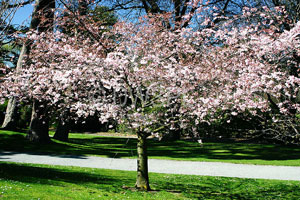Ornamental Flowering Cherry Trees for Texas
 Question from Bijou:
Question from Bijou:
I have enjoyed reading your gardening forum. The information you provide is helpful to gardening pros and beginners. My gardening question is about my wanting to plant four ornamental flowering cherry trees and should I purchase them bareroot or potted. I have always want to plant flowering cherry trees, similar to the ones grown in Washington, DC. I want to plant a few of the flowering cherry trees like Kwanzan or Yoshino and I would like to know will they grow and bloom and survive in the Texas weather? Would you recommend purchasing them bareroot or potted? I have never planted a bareroot tree or plant. I am concerned about the quality of the tree and will it grow if I go with the bareroot. Can you provide some information on the precautions and the expectations of planting a flowering cherry trees? Thank You and I look forward to your response.
Answer from Pat:
Yes, flowering cherry trees (Prunus) will grow in Dallas and the Texas hill country and other parts of Texas, though depending on the weather in a particular year or location, harsh winds or temperature swings may occasionally cause blossoms to fall off. Most varieties of flowering cherry need winter chill, but in warmer areas Taiwan cherry (Prunus campanulata) is one of the best choices, since it is low-chill. Even if one year the bloom is not the greatest, another year you may have spectacular success. You might also consider flowering peach which grows well in most parts of Texas. Though beautiful in bloom these trees may not look as great for the rest of the year, so consider putting them towards the back of a border, and backing them with green so they show up when in bloom. Also these trees are susceptible to borers, so be sure to clean them up and use dormant spray several times in winter and keep a clean garden.
I think it’s much the best to go to a top-flight nursery and purchase the tree bareroot. Trees in cans sometimes have roots wound around or they have the chance of root rot, disease or pest problems. It is easy to plant bareroot. The hole should be wider than deep and you need to make a mound in the center, over which you will spread the roots. You can also put slow release fertilizer half way up the hole as you refill it with the native soil, but do not allow fertilizer to touch the roots. Your nursery should provide appropriate instructions. If they tell you to use planter mix or Vit B 1 ignore these instructions, however. These instructions are to make the nursery make more money but are not the correct things to do. Trees must be planted into the native soil and Vit B was proven over and over again not to work.
Most people who fail when planting bareroot, simply do not water enough after planting. Be sure to water at least twice after planting, again the next day, and again 3 days after that. Water 3 times the following week and twice a week for the next month. Then taper off to once per week deeply.
When purchasing your bare root tree, stay away from big box stores since these places purchase plants in bulk and the varieties may be incorrect for your area. In some cases, also, though not always, the plants may be distressed. (Common problems with nursery stock at big box stores include houseplants with pots filled to top of pot and not in optimum soil mix, trees available in popular varieties like ‘Delicious’ apples sold in areas where they are not adapted and plants have been overwatered or under-watered due to untrained help.)
A good nursery in the same climate zone in which you reside, however, will have done the research and purchased the best varieties for your location. I hesitate to make a recommendation of a variety of a flowering cherry for your specific climate, since I don’t know in what part of Texas you live in, and even then I most likely will not know as much as your local nursery or a horticultural expert in your area. The USDA climate zones for Texas are Zones 6,7,8, and 9. Unfortunately, the Sunset climate zones do not cover much of Texas, except for the extreme west around El Paso, which is Sunset Zone 10 but is USDA Zone 8. Further east, in Hudspeth and Culbertson Counties the climate switches to USDA Zone 7. Your local nursery will know which USDA climate zone you are in and they should know which plants are best adapted to your particular microclimate as well.
I am delighted you like my garden forum and find the information helpful. Thanks for writing.

